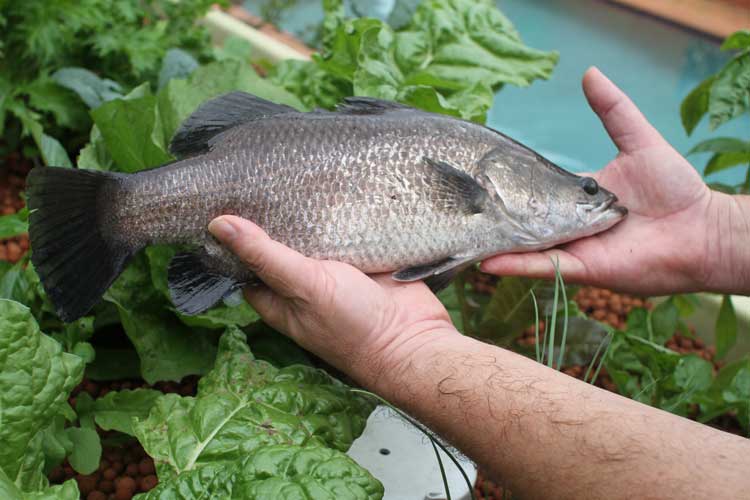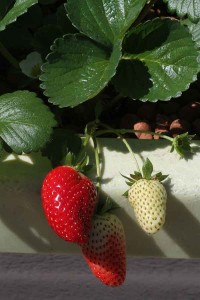Aquaponics and Sunlight

Stress is a big killer of fish. This barramundi grown in aquaponics has a fine slime coating preventing bacterial infections.
Recently a friend was telling me about how difficult it was to grown strawberries in his aquaponics system. He didn’t have any success in growing them and was wondering if he was doing something wrong or indeed, if this aquaponics thing was over-hyped?
He didn’t have a green thumb he said, because certain other plants in his system weren’t doing too well either.
Closer investigation revealed that the fish were not happy and some had even died. Some of the surviving fish had bacterial infections on their sides and looked distressed.
An aquaponics forum had suggested that he add salt into the system to rejuvenate the fish. This worked to a certain extent but his fish were still progressively dieing and the salt level was affecting salt-sensitive plants like strawberries.
We noticed that the site where his aquaponics system was erected was placed in a poor location. Sited under balcony eaves, it hardly got any sunshine throughout the day so the plants looked weak and spindly. Not robust and healthy as they should.
No matter how good an aquaponics system is designed and built, it still must adhere to some basic principles of growing food.
It must be sited in a sunny location that has around 6 hours of sunshine per day. If you run an indoor system then you must use grow lights to enable the plants to grow. We regularly clip a tall hedge plant that threatens to block the sunshine from falling on one of our grow-beds. Keeping the sun shining on your growbeds makes a big difference.
Monitor your sunlight and watch where the shadows strike in the morning and afternoon. Are there any overhanging trees or branches that should be trimmed? If you are fortunate to have a nice sunny spot near your house then that is the ideal location to site your system.
It seems like common sense but there are a growing number of people who place too much reliance on the “miracle” of aquaponics to solve basic plant requirement issues and fail to understand the basics principals of normal gardening. Don’t let the technology fool you. People too often get swept away talking about pumps and plumbing and forget that the system is basically using nature to do all the heavy work.
So back to the friend with a poor system and why his strawberries and fish weren’t happy. He had setup a system in a bad location and then compounded his problems by stressing his fish! Everyone who came to his house was treated to a look at his struggling fish. Out they came in the net to be viewed.
Inevitably their natural slime coating was disturbed. Fish have a slippery slime coating that covers their scales and skin.
The slime coating acts as a defensive barrier to protect against nasty bacteria, fungal pathogens and parasites.
The constant stress of netting the fish aggravated the situation. Fins were caught in the netting and sometimes the slippery fish were dropped and injured as they flipped on the ground.
Stress is one of the biggest killers of fish. Don’t aggravate your fish with unnecessary handling. Adding salt as a tonic to the system up to 3ppt or three kilos of salt per 1000 litres of water can help the fish recover but it also compounds the situation with growing salt sensitive plants like strawberries.
The simple rule of thumb is site your system in a sunny location. Don’t stress the fish. Have an adequate number of fish to provide the nutrients to keep the plants well fed. Add a little maxicrop or seaweed concentrate extract to provide additional nutrients not found in normal fish feed pellets.
Occasionally if you notice your plants looking a little yellow and not that rich vibrant green. Adding a little chelated iron will strengthen their colour and eliminate any plant weakness. Chelated iron is a soluble power that enables plants to take up the iron through their root system. Keeping your pH at around 6.8 will mean the plant can take up nutrients at an optimal rate and develop at their peak capacity. Throwing a rusty horse-shoe into the system doesn’t work as an iron substitute. We have tried it!
One or two teaspoons of chelated iron added every few months is more than enough to keep your plants healthy and happy. We rarely have issues with our fish and leave them alone to grow and develop normally and they reward us with providing lots of nutrients for the plants to take up. In fact the less interaction you have with the fish, the better.
By changing the location of his system and placing it in a sunny spot in the garden, our friend was able to eliminate potential problems from compounding. He also maximized both his fish health and plant growth.









Recent Comments